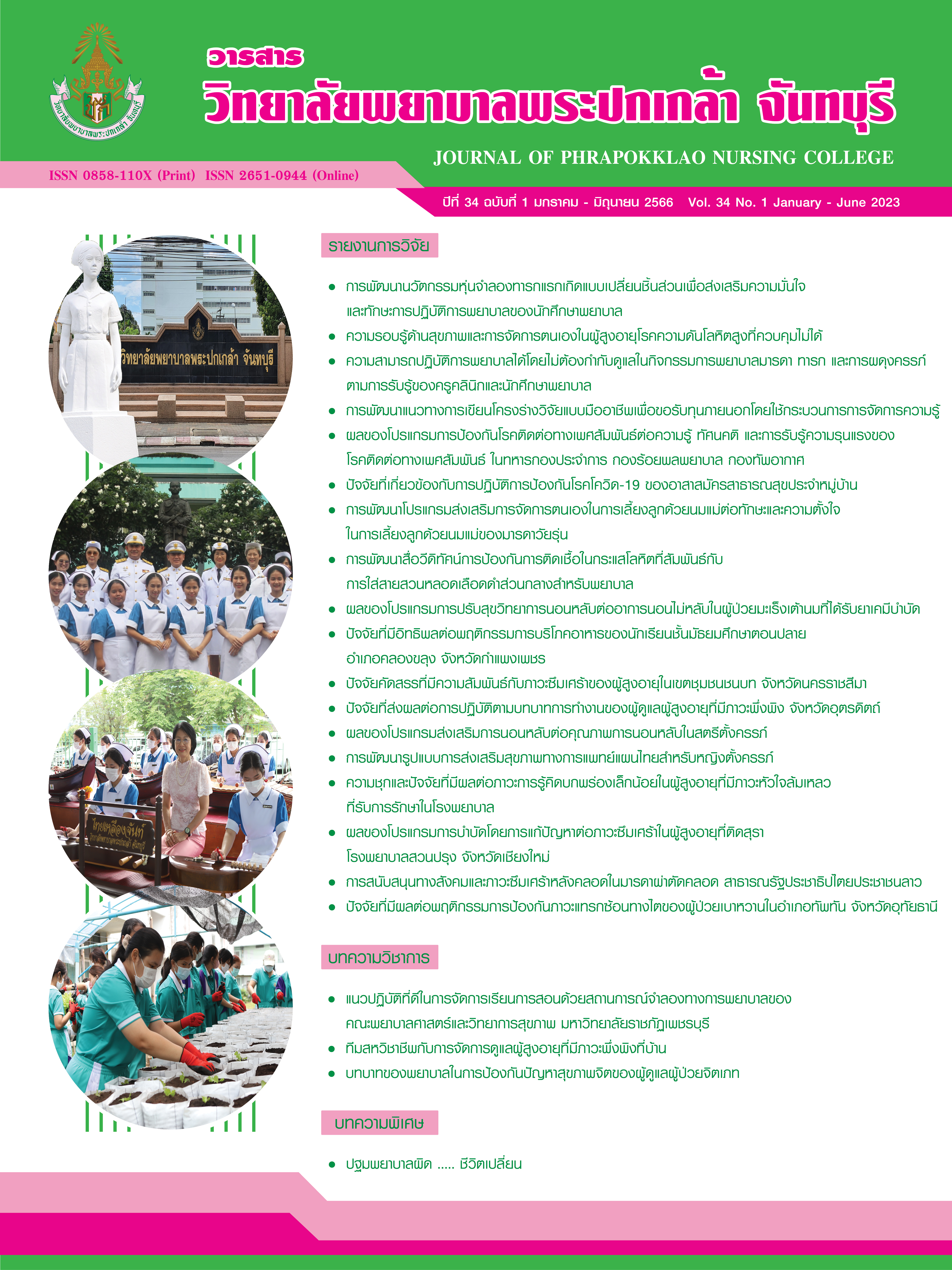Health Literacy and Self-management among Older Persons with Uncontrolled Hypertension
Keywords:
Health literacy, Self-management, Older persons with uncontrolled hypertensionAbstract
This descriptive correlational research aimed to examine the relationship between health literacy and self-management among older persons with uncontrolled hypertension. The participants consisted of 82 older persons with uncontrolled hypertension who visited the hypertension clinic at Bang Saphan Hospital and three sub-district health promoting hospitals in Bang Saphan District, Prachuap Khiri Khan Province. The research instruments included the demographic data form, the health literacy scale with reliability of .82, and the self-management scale with reliability of .99. Data were collected from April to May, 2020. Statistics used for data analysis included frequency, percentage, mean, standard deviation, and Pearson’s product moment correlation.
The research results revealed that the total mean scores of health literacy and self-management among older persons with uncontrolled hypertension were at a moderate level (M = 35.78, SD = 4.39 and M = 71.43, SD = 6.36, respectively). Health literacy was positively statistically significantly related to self-management among older persons with uncontrolled hypertension (r = .393, p < .001).
This research suggests that health care providers should assess health literacy and self-management among older persons with uncontrolled hypertension in order to promote their health literacy and self-management. As such, older persons will provide more suitable blood pressure control.
References
กรรณิการ์ การีสรรพ์, พรทิพย์ มาลาธรรม, และนุชนาฏ สุทธิ. (2562). ความสัมพันธ์ระหว่างความรอบรู้ด้านสุขภาพ ความรู้เกี่ยวกับการควบคุมโรคความดันโลหิตสูง และพฤติกรรมการดูแลสุขภาพของผู้สูงอายุที่เป็นโรคความดันโลหิตสูง. รามาธิบดีพยาบาลสาร, 25(3), 280–295.
กฤษณาพร ทิพย์กาญจนเรขา, และสำลี สาลีกุล. (2562). บทบาทพยาบาลในการป้องกันและการจัดการกับการใช้ยาที่ไม่เหมาะสมในผู้สูงอายุ. วารสารพยาบาลทหารบก, 20(1), 31–39.
กลุ่มรายงานมาตรฐาน กระทรวงสาธารณสุข. (2561). การป่วยด้วยโรคไม่ติดต่อที่สำคัญ อัตราป่วยด้วยโรคความดันโลหิตสูงต่อแสนประชากร. สืบค้นจาก https://hdcservice.moph.go.th/hdc/reports/
จริยา นพเคราะห์, โรจนี จินตนาวัฒน์, และทศพร คำผลศิริ. (2563). ความรอบรู้ด้านสุขภาพและการจัดการตนเองในผู้สูงอายุที่เป็นโรคเบาหวานชนิดที่ 2. พยาบาลสาร, 47(2), 251–261.
ณัฐธิดา จงรักษ์, และนัฎฐิกา นวพันธุ์. (2562). ความสัมพันธ์ระหว่างปัจจัยทางกายภาพของพื้นที่ว่างสาธารณะกับรูปแบบปฏิสัมพันธ์ทางสังคมของผู้สูงอายุ กรณีศึกษา สวนสาธารณะในพื้นที่เมือง จังหวัดพิษณุโลก. วารสารวิชาการคณะเทคโนโลยีอุตสาหกรรม มหาวิทยาลัยราชภัฏลำปาง, 12(1), 27–39.
เบญจมาศ ถาดแสง, ดวงฤดี ลาศุขะ, และทศพร คำผลศิริ. (2555). ผลของโปรแกรมสนับสนุนการจัดการตนเองต่อพฤติกรรมการจัดการตนเองและค่าความดันโลหิตของผู้สูงอายุที่มีโรคความดันโลหิตสูง. พยาบาลสาร, 39(4), 124–137.
พนิดา จันทร์ดีแก้วสกุล, นันทิยา วัฒายุ, และนันทวัน สุวรรณรูป. (2561). ปัจจัยทำนายพฤติกรรมการจัดการตนเองของผู้ป่วยความดันโลหิตสูงชนิดไม่ทราบสาเหตุที่ควบคุมไม่ได้. วารสารพยาบาลศาสตร์, 36(1), 31–43.
พิษณุรักษ์ กันทวี, และสถิรกร พงศ์พานิช. (2562). ความแตกฉานทางสุขภาพในกลุ่มผู้สูงอายุตำบลป่าตึง อำเภอแม่จัน จังหวัดเชียงราย. เชียงรายเวชสาร, 11(1), 73–83.
รัตนพงศ์ คำเผ่า, และน้ำเงิน จันทรมณี. (2561). การศึกษาทักษะการจัดการตนเองในผู้สูงอายุโรคความดันโลหิตสูง เขตบริการโรงพยาบาลส่งเสริมสุขภาพตำบลบ้านเหล่า อำเภอแม่ใจ จังหวัดพะเยา. ใน รายงานสืบเนื่องการประชุมวิชาการบัณฑิตศึกษา ครั้งที่ 4 (น. 12–22). กองบริหารงานวิจัยและประกันคุณภาพการศึกษา มหาวิทยาลัยพะเยา. สืบค้นจาก http://www.dra.up.ac.th/front/files/pgrc/Proceeding_PGRC4_2561.pdf
ราตรี อร่ามศิลป์, พัทธยา เกิดกุล, สายใจ จารุจิตร, และวรรณศิริ ประจันโน. (2561). พฤติกรรมการจัดการตนเองของผู้ป่วยโรคความดันโลหิตสูงในอำเภอเมือง จังหวัดจันทบุรี. วารสารวิทยาลัยพยาบาลพระปกเกล้า จันทบุรี, 29(1), 68–77.
วิชัย เอกพลากร. (บ.ก.). (2559). รายงานการสำรวจสุขภาพประชาชนไทยโดยการตรวจร่างกาย ครั้งที่ 5 พ.ศ. 2557. กรุงเทพฯ: อักษรกราฟฟิคแอนด์ดีไซน์.
สาวิตรี วิษณุโยธิน, ฉวีวรรณ บุญสุยา, สำลี เปลี่ยนบางช้าง, รัตนา สำโรงทอง, และเสาวนีย์ ทองนพคุณ. (2562). ความแตกฉานทางสุขภาพและพฤติกรรมการจัดการตนเองของผู้ป่วยความดันโลหิตสูงที่ควบคุมความดันโลหิตไม่ได้ในระดับบริการปฐมภูมิของชุมชนเขตเมือง จังหวัดนครราชสีมา ประเทศไทย. วารสารสาธารณสุขและการพัฒนา, 17(1), 1–13.
สุมาพร สุจำนงค์, มณีรัตน์ ธีระวิวัฒน์, และนิรัตน์ อิมามี. (2556). ปัจจัยที่มีความสัมพันธ์กับการจัดการตนเองของผู้ป่วยความดันโลหิตสูง โรงพยาบาลส่งเสริมสุขภาพตำบลตลาดขวัญ จังหวัดนนทบุรี. วารสารวิทยาลัยพยาบาลบรมราชชนนี กรุงเทพ, 29(2), 20–30.
แสงเดือน กิ่งแก้ว, และนุสรา ประเสริฐศรี. (2559). ความสัมพันธ์ระหว่างความฉลาดทางสุขภาพและพฤติกรรมสุขภาพของผู้สูงอายุที่เป็นโรคเรื้อรังหลายโรค. วารสารพยาบาลกระทรวงสาธารณสุข, 25(3), 43–54.
อามานี แดมะยุ, ศิริรัตน์ ปานอุทัย, และพนิดา จันทโสภีพันธ์. (2563). ความสัมพันธ์ระหว่างความรอบรู้ด้านสุขภาพและการจัดการตนเองในผู้สูงอายุไทยมุสลิมที่เป็นโรคความดันโลหิตสูง. วารสารสภาการพยาบาล, 35(3), 87–107.
Amarya, S., Singh, K., & Sabharwal, M. (2018). Ageing process and physiological changes. Retrieved from file:///C:/Users/Admin/Downloads/Ageing_Process_and_Physiological_Changes.pdf
Ansari, H., Almasi, Z., Ansari-Moghaddam, A., Mohammadi, M., Peyvand, M., Hajmohammadi, M., & Bagheri, F. (2016). Health literacy in older adults and its related factors: A cross-sectional study in Southeast Iran. Health Scope, 5(4), e37453. doi:10.17795/jhealthscope-37453
Benjamin, E. J., Virani, S. S., Callaway, C. W., Chamberlain, A. M., Chang, A. R., Cheng, S., … Muntner, P. (2018). Heart disease and stroke statistics – 2018 update: A report from the American Heart Association. Circulation, 137(12), e67–e492. doi:10.1161/CIR.0000000000000558
Buford, T. W. (2016). Hypertension and aging. Ageing Research Reviews, 26, 96–111. doi:10.1016/J.ARR.2016.01.007
Campbell, A. P. (2017). DASH eating plan: An eating pattern for diabetes management. Diabetes Spectrum, 30(2), 76–81. doi:10.2337/ds16-0084
Chajaee, F., Pirzadeh, A., Hasanzadeh, A., & Mostafavi, F. (2018). Relationship between health literacy and knowledge among patients with hypertension in Isfahan province, Iran. Electronic Physician, 10(3), 6470–6477. doi:10.19082/6470
Ding, W., Li, T., Su, Q., Yuan, M., & Lin, A. (2018). Integrating factors associated with hypertensive patients’ self-management using structural equation modeling: A cross-sectional study in Guangdong, China. Patient Preference and Adherence, 12, 2169–2178. doi:10.2147/PPA.S180314
Flynn, S. J., Ameling, J. M., Hill-Briggs, F., Wolff, J. L., Bone, L. R., Levine, D. M., … Boulware, L. E. (2013). Facilitators and barriers to hypertension self-management in urban African Americans: Perspectives of patients and family members. Patient Preference and Adherence, 7, 741–749. doi:10.2147/PPA.S46517
Ishikawa, H., Takeuchi, T., & Yano, E. (2008). Measuring functional, communicative, and critical health literacy among diabetic patients. Diabetes Care, 31(5), 874–879. doi:10.2337/dc07-1932
James, P. A., Oparil, S., Carter, B. L., Cushman, W. C., Dennison-Himmelfarb, C., Handler, J., … Ortiz, E. (2014). 2014 evidence-based guideline for the management of high blood pressure in adults: Report from the panel members appointed to the Eighth Joint National Committee (JNC 8). JAMA, 311(5), 507–520. doi:10.1001/jama.2013.284427
Lorig, K. R., & Holman, H. R. (2003). Self-management education: History, definition, outcome, and mechanisms. Annals of Behavioral Medicine, 26(1), 1–7. doi:10.1207/S15324796ABM2601_01
Mensah, G. A. (2016). Hypertension and target organ damage: Don’t believe everything you think!. Ethnicity & Disease, 26(3), 275–278. doi:10.18865/ed.26.3.275
Nutbeam, D. (2000). Health literacy as a public health goal: A challenge for contemporary health education and communication strategies into the 21st century. Health Promotion International, 15(3), 259–267. doi:10.1093/heapro/15.3.259
World Health Organization. (2013). World health statistics 2013. Retrieved from https://www.who.int/publications/i/item/9789241564588
Downloads
Published
How to Cite
Issue
Section
Categories
License
Copyright (c) 2023 JOURNAL OF PHRAPOKKLAO NURSING COLLEGE

This work is licensed under a Creative Commons Attribution-NonCommercial-NoDerivatives 4.0 International License.
เนื้อความ ข้อมูล และรายการอ้างอิงที่ผู้เขียนใช้ในการเขียนบทความเพื่อลงตีพิมพ์ในวารสารวิทยาลัยพยาบาลพระปกเกล้า จันทบุรี ถือเป็นความคิดเห็นและความรับผิดชอบของผู้เขียน คณะผู้จัดทำวารสารไม่จำเป็นต้องเห็นพ้องด้วยหรือร่วมรับผิดชอบ
บทความที่ได้รับการลงตีพิมพ์ในวารสารวิทยาลัยพยาบาลพระปกเกล้า จันทบุรี ถือเป็นลิขสิทธิ์ของวารสารวิทยาลัยพยาบาลพระปกเกล้า จันทบุรี หากหน่วยงานหรือบุคคลใดต้องการนำส่วนหนึ่งหรือทั้งหมดของบทความไปเผยแพร่ต่อเพื่อวัตถุประสงค์ใด ๆ จะต้องได้รับอนุญาตจากบรรณาธิการวารสารก่อน



